Music Appreciation
Related: About this forumOn this day, Tuesday, February 11, 1964, the Beatles played their first US concert.
Here comes a big post. I say something about this event every year. It's my longest post of the year.
After performing on Ed Sullivan, the Beatles packed up and headed over to the (new) Pennsylvania Station. The took the train to Washington, DC. They played their first US concert there, at the building that had begun life as the Uline Arena, on February 11, 1964.
The Uline Arena, also known as the Washington Coliseum, was an indoor arena in Washington, D.C. located at 1132, 1140, and 1146 3rd Street, Northeast, Washington, D.C. It was the site of the first concert by The Beatles in the United States. Once abandoned and used as a parking facility, today it has been renovated and houses offices and a REI store.
It is directly adjacent to the railroad tracks, just north of Union Station, and bounded by L and M Streets.
The arena was home of the Washington Capitols of the Basketball Association of America (1946-1949) and National Basketball Association (1949-1950), who were once coached by Red Auerbach. Later, the American Basketball Association's Washington Caps played there in 1969–1970. It also was host to many performances and athletic events of varying types, including ice skating, martial arts, ballet, music, circuses, and speeches. It held up to 11,000 people for events.
History
The 11,000-seat Uline Ice Arena, which opened in February, 1941, was built by Migiel J. "Uncle Mike" Uline for his ice hockey team, the Washington Lions of the now defunct Eastern Amateur Hockey League. Uline built the arena next to his ice business.
The first event at the new arena was Sonja Henie's Hollywood Ice Revue. Another of its earliest events was a pro-America rally in 1941 designed to promote U.S. entry into World War II, just weeks before the Japanese attack on Pearl Harbor brought the United States into the war on December 7, 1941. During the war, Uline repurposed the arena as a housing facility for U.S. service members. The arena remained segregated after its opening until January, 1948.
{snip}
Beatles concert
On February 11, 1964, The Beatles played their first concert in the United States at the Washington Coliseum, less than 48 hours after the band's appearance on The Ed Sullivan Show. Tickets to the show at the Coliseum ranged from $2 to $4. There were 8,092 fans at the concert, which was opened by The Chiffons, The Caravelles, and Tommy Roe. The Beatles opened with "Roll Over Beethoven." In 2014, Roe reflected that "the marquee didn't say anything about the other acts. It just said 'The Beatles.' It was all about them. But I wasn't offended. That's just the way it worked. I was there to do my two songs and then get off the stage." The Beatles had a 12 song set and played for approximately 40 minutes.
Other events
{snip}
Jewelry wholesaler Harry G. Lynn bought the arena in 1959 for $1 million. In 1959, Elijah Muhammad gave a speech there, and Malcolm X once spoke there as well. In 1960, Lynn renamed the building the Washington Coliseum.
Bob Dylan performed at the Washington Coliseum, and the photograph of Dylan on the cover of Bob Dylan's Greatest Hits was taken at a concert at the Coliseum on November 28, 1965. Chuck Brown also performed there.
{snip}
They had planned to fly, but:
{snip}
Feb. 11, 1964
After their history-making appearance on “The Ed Sullivan Show” on Feb. 9, the Beatles perform the first full concert of their American tour at the Washington Coliseum; a morning snowstorm snarls New York airports, leading to a last-minute decision to travel from New York by train; the Beatles and the New York press corps travel in a chartered Richmond, Fredericksburg & Potomac Railroad 10-6 sleeping car King George (built in 1948 for New York-Richmond-Norfolk pool service) attached to the Morning Congressional leaving New York at 11:00 AM; John Lennon and Paul McCartney walk through the entire train signing autographs; a crowd of 3,000 waiting fans create bedlam on arrival at Washington Union Station. (rf&pgroup, Wayner -verify NYT)
Feb. 12, 1964
The Beatles and their press entourage return to New York via the PRR for a concert at Carnegie Hall, this time in a PRR heavyweight lounge car; the Beatles are practically prisoners of the press during the trip and engage in the kind of hijinks that will characterize their two movies for the photographers; in a futile effort to evade the 10,000 fans milling around Penn Station, the Beatles’ car is switched to a different platform, but they are forced to make a mad dash for a waiting taxi. (rf&pgroup)
British Pathé
3.09M subscribers
7,809 views Apr 13, 2014
Washington D.C., United States of America (USA).
Various shots of the young Beatles fans, mostly teenagers outside building where the famous British band is about to arrive, some waving to camera. GV. Exterior of the Washington Station with snow falling. Various shots of 'Welcome Beatles' banners and youngsters waiting in station. MV. Train pulling into snow covered Washington Station. Various shots of the Beatles members (John Lennon, Paul MacCartney, George Harrison and Ringo Star) getting out of train and giving short statements to the press. Snow still falling as they make their way along platform.
(F.G.)
Date found in the old record - 12/02/1964.
FILM ID:3159.31
{snip}
The train was pulled by a Pennsylvania Railroad GG1, which enters the scene at 1:11. Darn, I can't make out the number.
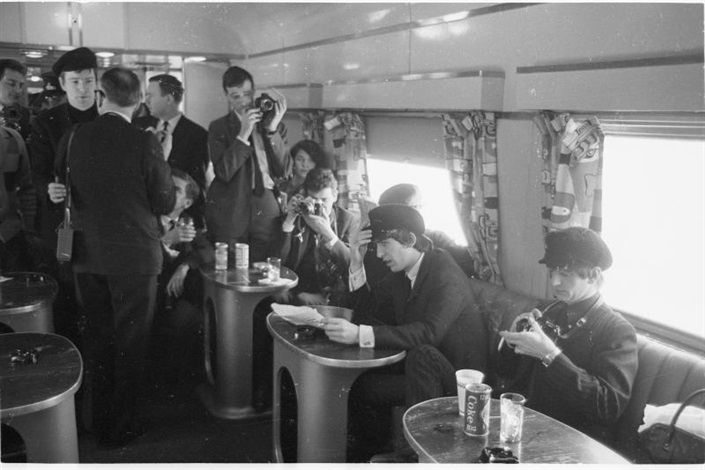
On the train:

SLRs and rangefinders (including a Leica M-something?) capture the scene in the lounge.
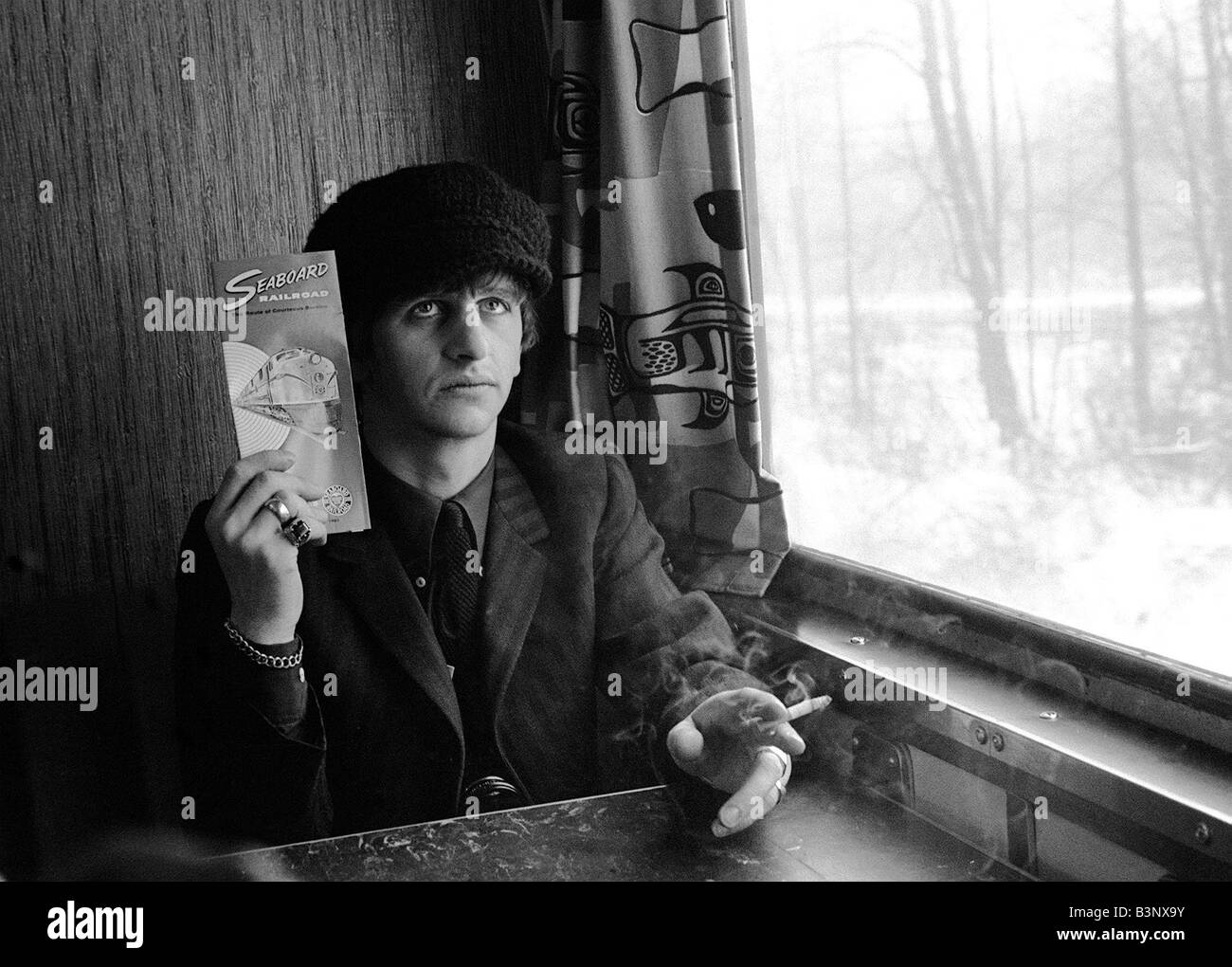
Ringo holds up a Seaboard Air Line Railroad timetable. That's a swell Seaboard EMD E7 locomotive on the cover.

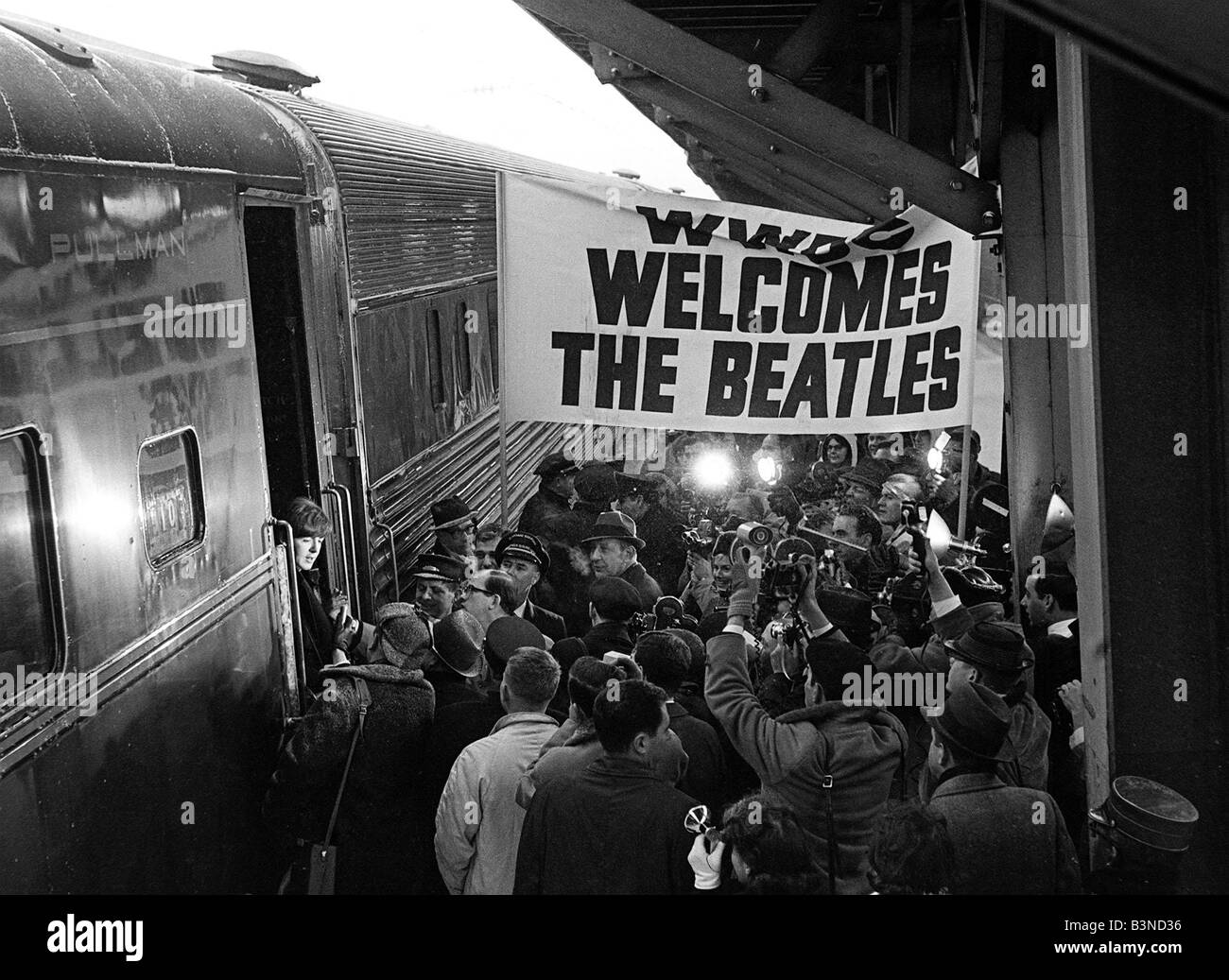
WWDC Welcomes The Beatles
 {bad link}
{bad link}
Walking down the platform at Union Station:

That night:
02/10/2014 / in DC / by Patrick Kiger
Paul McCartney and John Lennon are ushered through the crowd at Union Station on February 11, 1964. (Photo credit: Mike Mitchell)
It's hard to imagine that anyone would think the Beatles might not be a big enough concert draw. But when Harry G. Lynn, owner of the old Washington Coliseum at 3rd and M streets NE, was approached by local radio station WWDC in late 1963 about the possibility of booking the then-nascent British pop music sensations for their debut U.S. concert on Feb. 11, 1964, he wasn't convinced that he would be able to sell the 8,000-plus tickets that it would take to fill his arena. That's why Lynn reportedly insisted upon hedging his bet by booking several other acts — the Caravelles, Tommy Roe and the Chiffons.
{snip}
Last Updated: 11/11/2020
Dave Lifton
Published: February 11, 2016
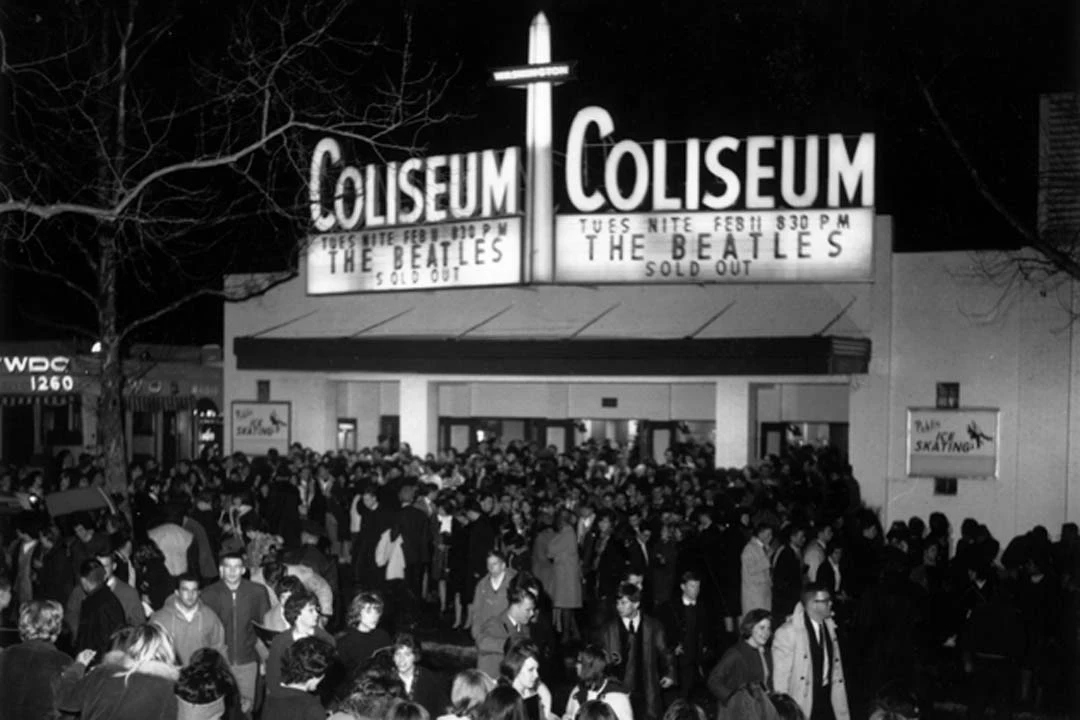
Hulton Archive, Getty Images
{snip}

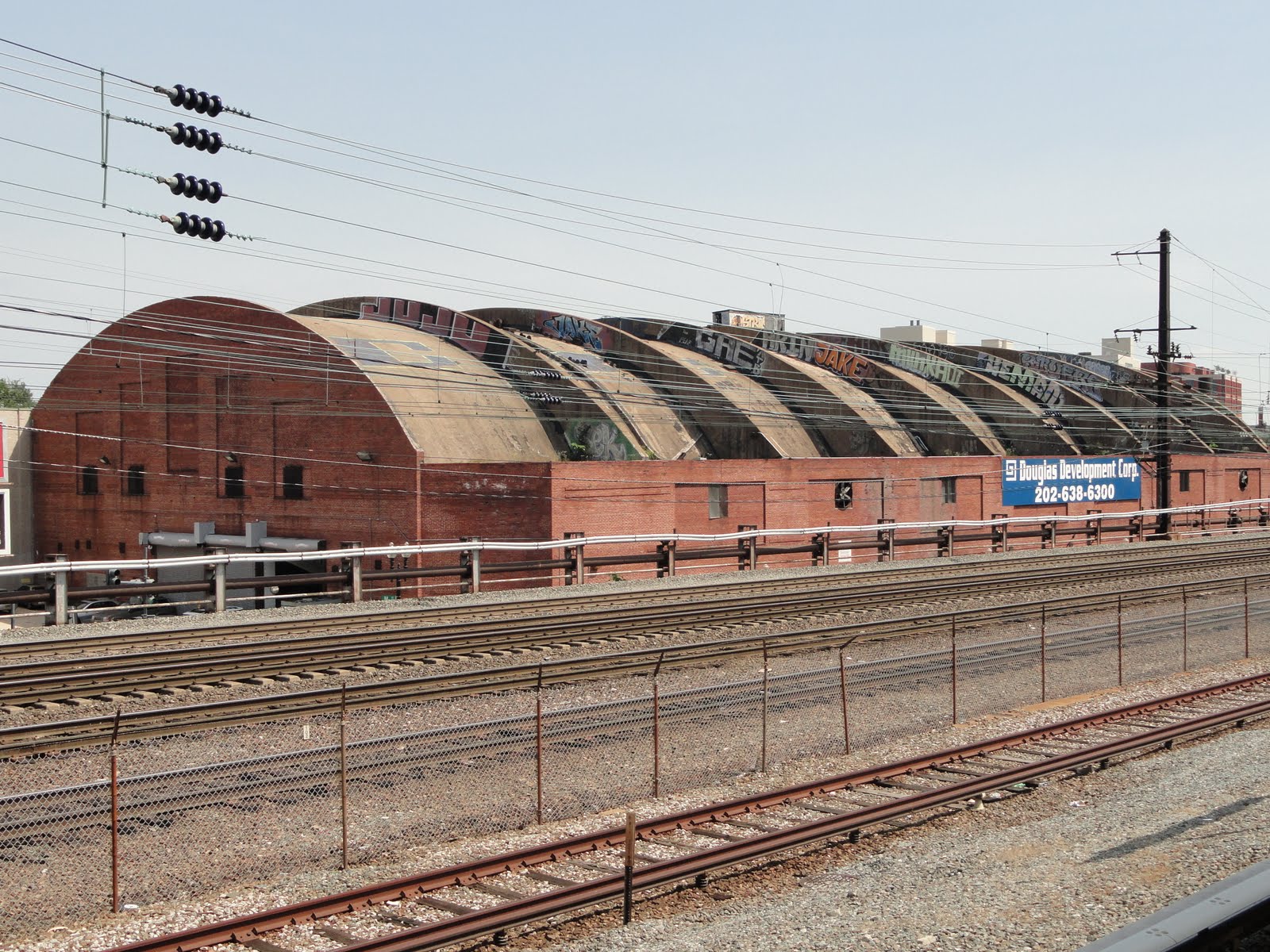
You go right by the old Uline Arena on the WMATA Metrorail Red Line when you go from Union Station to Fort Totten. These pictures of the building were taken from a Red Line train near what is now called the NoMa–Gallaudet U station.
{snip}
While still under construction in January 2004, the station name was changed from New York Ave to New York Ave–Florida Ave–Gallaudet U. The change was made to reflect its location near both Florida Avenue and Gallaudet University.
On November 20, 2004, the station opened as the 84th station, and first infill station, on the Metro system. The final cost was $103.7 million with the federal government and private land owners each contributing $25 million and the D.C. government contributing $53.7 million. Its construction has served as a catalyst for new development and redevelopment of the NoMa neighborhood. The station was renamed to NoMa–Gallaudet U on November 3, 2011, and formally christened with the new name on June 13, 2012.
{snip}
You can see the third rail, used for Metrorail's electric power, next to the tracks in the foreground. The tracks further away have overhead electrification. They are the southern end of Amtrak's Northeast Corridor.
The building is still there, but it doesn't look like that now. The distinctive arches are still instantly recognizable, but the building has been renovated. Today it's an REI:

Source: D.C.’s Historic Washington Coliseum Is Now an REI Flagship and Test Lab
The following article was updated on December 17, 2023. There was no change in the link. The address was unchanged. Here is the version that appeared before December 17, 2023:
On Dec. 17, 1963, the U.S. still had no idea what was in store. The Beatles had yet to appear on The Ed Sullivan Show, where they seemingly overnight changed the landscape of pop music forever. That wouldn't occur until February 1964. But on a mid-December day in 1963, Carroll James of WWDC in Washington, D.C., played a Beatles record. He wasn't the first to do so in the U.S., but it was when things really caught fire.
According to Beatles Interviews, a D.C. teenager had mailed in a request to WWDC to hear the Beatles. "I wrote that I thought they would be really popular here, and if [James] could get one of their records, that would really be great," said Marsha Albert, that insightful teen who made the request.
Carroll James somehow secured the Beatles' new single, "I Want to Hold Your Hand," which had yet to be issued in the United States. The phones lit up and made the song an instant listener favorite. Capitol Records released "I Want to Hold Your Hand" in the U.S. the following week, and it eventually reached the No. 1 spot in Billboard on Feb. 1, 1964 – a place it would occupy for 11 straight weeks.
A month earlier on Nov. 18, the Beatles made their first appearance on U.S. television as part of the Huntley-Brinkley Report, which featured a four-minute segment by reporter Edwin Newman. Three weeks before that, on Oct. 29, the Washington Post ran a story with the headline, "Thousands of Britons 'Riot' – Liverpool Sound Stirs Up Frenzy." Both Time and Newsweek published their own Beatles stories in mid-November. The rest is history
Here is the December 17, 2023, version:
Dave Swanson | Published: December 17, 2023
On Dec. 17, 1963, the U.S. still had no idea what was in store. The Beatles had yet to appear on The Ed Sullivan Show, where they seemingly overnight changed the landscape of pop music forever. That wouldn't occur until February 1964.
Then Carroll James of WWDC in Washington, D.C., played a Beatles record on a mid-December day in 1963. He wasn't the first to do so in the U.S., but it was when things really caught fire.
A D.C. teenager had mailed in a request to WWDC to hear the Beatles, according to Beatles Interviews. "I wrote that I thought they would be really popular here, and if [James] could get one of their records, that would really be great," said Marsha Albert, that insightful teen who made the request.
Carroll James somehow secured the Beatles' new single, "I Want to Hold Your Hand," which had yet to be issued in the United States. The phones lit up and made the song an instant listener favorite. Capitol Records released "I Want to Hold Your Hand" in the U.S. the following week, and it eventually reached the No. 1 spot in Billboard on Feb. 1, 1964 – a place it would occupy for 11 straight weeks.
The Beatles made their first appearance on U.S. television a month earlier on Nov. 18 as part of the Huntley-Brinkley Report, which featured a four-minute segment by reporter Edwin Newman. Three weeks before that, on Oct. 29, the Washington Post ran a story with the headline, "Thousands of Britons 'Riot': Liverpool Sound Stirs Up Frenzy." Both Time and Newsweek published their own Beatles stories in mid-November. The rest is history.
{snip}
Photos of The Beatles in Washington, D.C.
This site is flat-out excellent:
Feb-March 1964
When the Beatles first came to the U.S. in 1964, primarily to appear on the Ed Sullivan Show in New York on February 9th, 1964, they also performed two live concerts.
The first of these concerts — and their first ever in the U.S. — was performed in Washington, D.C. at the Washington Coliseum on February 11th.
{snip}

Ticket stub to Beatles' first live American concert in Washington, D.C., February 11th, 1964.
{snip}
___________________________________
Date Posted: 9 July 2008
Last Update: 12 July 2016
Comments to: jdoyle@pophistorydig.com
Article Citation
(Original Posting) Jack Doyle, “Beatles’ Closed-Circuit Gig, Feb-March 1964,”
PopHistoryDig.com, July 9, 2008.
(Title Change) Jack Doyle, “Beatles’ D.C. Gig,” Feb-March 1964,
PopHistoryDig.com, January 29, 2014.
__________________________________
Sources, Links & Additional Information
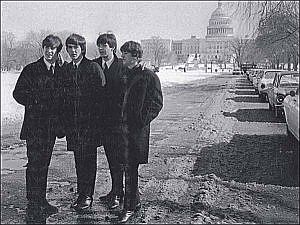
Beatles on D.C. mall with U.S. Capitol, Feb 1964.
Jerry Doolittle, “Beatles Arrive, Teen- Agers Shriek, Police Do Their Duty, and That’s That,” The Washington Post-Times Herald, February 12, 1964, p. 1.
On YouTube.com, there are several videos of the Beatles’ February 1964 performance at the Washington Coliseum. These are typically grainy, black-and-white videos of various lengths, some 30 minutes or more, with shots of the Beatles performing, screaming fans, and the general pandemo- nium of that concert.
John S. Wilson, “2,900-Voice Chorus Joins the Beatles; Audience Shrieks and Bays and Ululates,” New York Times, February 13, 1964.
“Potential $4 Million Box Office For Beatles On Closed Circuit TV,” Broadcasting, February 24, 1964.
“Closed TV Shows Here for Beatles,” Dallas Morning News (Dallas, TX), March 2, 1964.
Myra MacPherson, “Help! The Day The Mania Came To Washington,” Washing- ton Post, February 7, 1984.
For more detail on Beatles’ tickets, see: “Closed-Circuit Telecast Tickets,” rarebeatles.com.
Jeff Shannon, Review of Beach Boys “Lost Concert” DVD (June 1999), Amazon.com.
Richie Unterberger, “The Beatles at the Washington Coliseum, Washington, DC, February 11, 1964.” See also his book, The Unreleased Beatles: Music and Film, available at Amazon and other booksellers.
For Beatles’ photographs of the 1964 D.C. performance see Rowland Scherman website.
J. Freedom duLac, “Paul McCartney, Al Gore, Tommy Roe Recall Beatles’ First U.S. Concert in D.C.,” Washington Post, December 3, 2010.
News Release, “The Beatles Now On iTunes: All 13 Legendary Beatles Studio Albums & Special Digital Box Set,” Apple.com, November 16, 2010.
David Beard, “The Beach Boys Lost Concert Completely Restored with the Beatles First American Concert Closed Circuit Broadcast,” Endless Summer Quartely.blogspot, December 16, 2010.
Chuck Miller, “Did the Beatles Appear in Albany Movie Theaters BEFORE “A Hard Day’s Night”? Yes They Did…,” TimesUnion.com, January 13, 2011.
See also, Pictorial History Of Uline Arena website for excellent photos of Beatles at D.C. concert (scroll to the bottom of the page).
WPGC Beatlemania Website.
Tommy Roe, E-mail correspondence to Jack Doyle, January 2, 2014.
___________________________________
New link for the 2024 thread, added Friday, February 9, 2024:
Beatlemania In D.C.: 60 Years Ago, The Beatles Performed Their First U.S. Concert At The Washington Coliseum
Elliot C. Williams elliotw@wamu.org
{snip}
Link to tweet
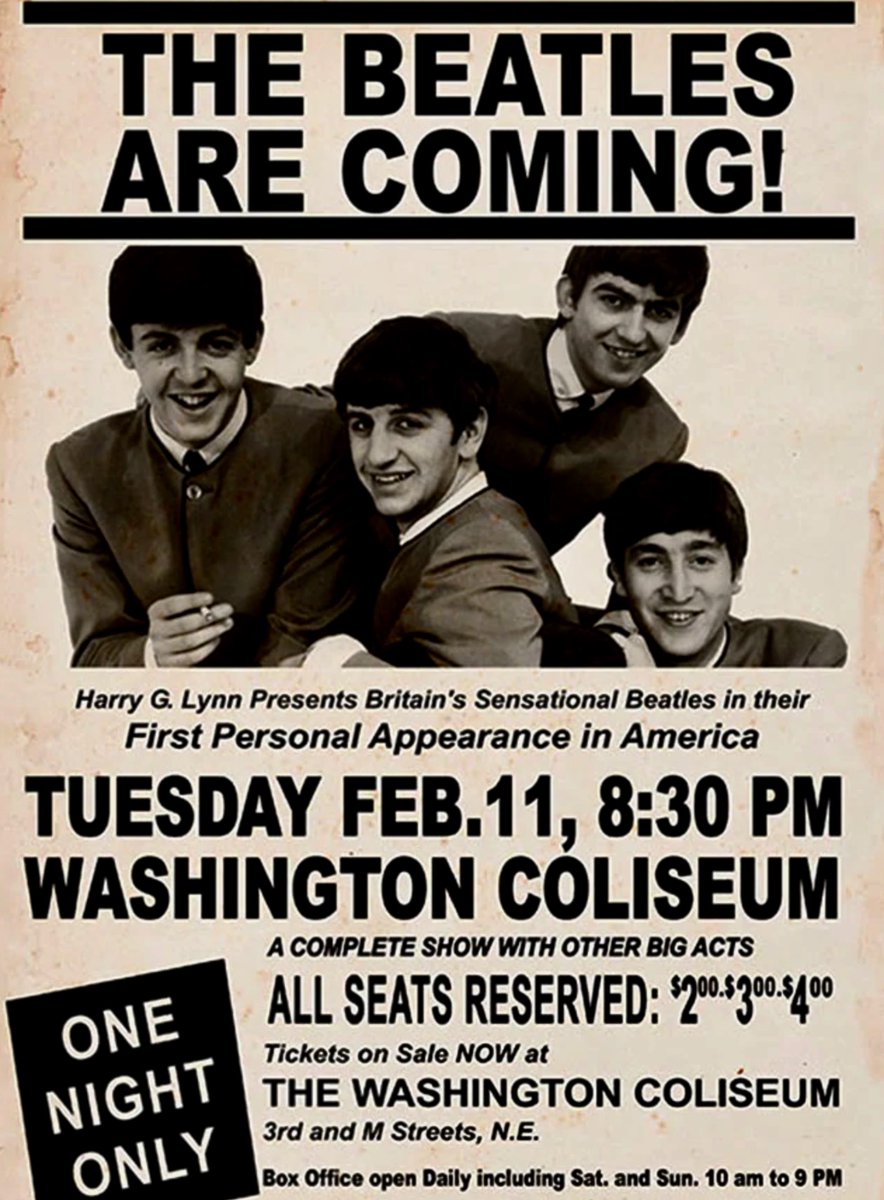
Sun Feb 11, 2024: On this day, Tuesday, February 11, 1964, the Beatles played their first US concert.
From ificandream:
Sun Dec 17, 2023: Dec. 17, 1963: A landmark date in Beatle history ...
Sat Feb 11, 2023: On this day, Tuesday, February 11, 1964, the Beatles played their first US concert.
Fri Feb 11, 2022: On this day, February 11, 1964, the Beatles played their first US concert.
Thu Feb 11, 2021: On this day, February 11, 1964, the Beatles played their first US concert.
Mon Feb 11, 2019: On this day in 1964, the Beatles played their first US concert.
Sun Feb 11, 2018: On this day in 1964, the Beatles played their first US concert.
mahatmakanejeeves
(64,455 posts)I’m adding some new links and additional information for the 2024 thread.
Beatlemania In D.C.: 60 Years Ago, The Beatles Performed Their First U.S. Concert At The Washington Coliseum
Elliot C. Williams elliotw@wamu.org
{snip}
[H]ow did the Beatles, who already had three hit singles by late 1963, end up playing their first major U.S. show in D.C.?
According to [Beatles historian Bruce Spizer, a tax attorney in New Orleans] and an episode of WAMU’s former show Metro Connection, it all comes back to Marsha Albert, then a 15-year-old student at Sligo Junior High (now Sligo Middle School).
Local radio helped launch Beatlemania in the U.S.
Like millions of Americans, Albert saw the CBS Evening News segment on The Beatles and wrote to WWDC (now DC101) requesting they play some of the band’s records.
WWDC disc jockey Carroll James got his hands on “I Want to Hold Your Hand” and invited Albert to join him on the air on Dec. 17, 1963, to introduce the song. Other radio stations around the country played recorded versions of that segment, and Capitol Records, in turn, released the record in the U.S. the day after Christmas, six weeks earlier than the label had originally planned.
{snip}
And
FIRST TO PLAY BEATLES IN U.S
By Claudia Levy
March 27, 1997 at 7:00 p.m. EST
Carroll James Jr., 60, the Washington disc jockey who in 1963 was the first to play a Beatles record on the radio in the United States, died of cancer March 24 at Holy Cross Hospital. He lived in Silver Spring.
In 1963, the Beatles were beginning to make their mark in Britain but had not yet toured the United States. A teenage fan asked Mr. James, then working at radio station WWDC, to play their hit "I Want to Hold Your Hand." The record was not due to be released in the United States until early 1964, just before the Beatles were to appear on "The Ed Sullivan Show."
WWDC arranged for a British flight attendant to carry a copy over. After Mr. James played the record Dec. 17, the station was swamped with requests for the song. A tape made of Mr. James's show was soon playing on stations across the country. As excitement over the group grew, Capitol Records released the record, six weeks earlier than planned.
{snip}
That's a great story, but it's not true. I emailed Elliot C. Williams to tell him.
Set the WABAC Machine to December 17, 2023:
From ificandream:
Sun Dec 17, 2023: Dec. 17, 1963: A landmark date in Beatle history ...
From that thread:
Sun Dec 17, 2023: He might have been the first in DC, but ...
The following article was updated on December 17, 2023. There was no change in the link. The address was unchanged. Here is the version that appeared before December 17, 2023:
Dave Swanson
On Dec. 17, 1963, the U.S. still had no idea what was in store. The Beatles had yet to appear on The Ed Sullivan Show, where they seemingly overnight changed the landscape of pop music forever. That wouldn't occur until February 1964. But on a mid-December day in 1963, Carroll James of WWDC in Washington, D.C., played a Beatles record. He wasn't the first to do so in the U.S., but it was when things really caught fire.
According to Beatles Interviews, a D.C. teenager had mailed in a request to WWDC to hear the Beatles. "I wrote that I thought they would be really popular here, and if [James] could get one of their records, that would really be great," said Marsha Albert, that insightful teen who made the request.
Carroll James somehow secured the Beatles' new single, "I Want to Hold Your Hand," which had yet to be issued in the United States. The phones lit up and made the song an instant listener favorite. Capitol Records released "I Want to Hold Your Hand" in the U.S. the following week, and it eventually reached the No. 1 spot in Billboard on Feb. 1, 1964 – a place it would occupy for 11 straight weeks.
A month earlier on Nov. 18, the Beatles made their first appearance on U.S. television as part of the Huntley-Brinkley Report, which featured a four-minute segment by reporter Edwin Newman. Three weeks before that, on Oct. 29, the Washington Post ran a story with the headline, "Thousands of Britons 'Riot' – Liverpool Sound Stirs Up Frenzy." Both Time and Newsweek published their own Beatles stories in mid-November. The rest is history.
{snip}
Here is the December 17, 2023, version:
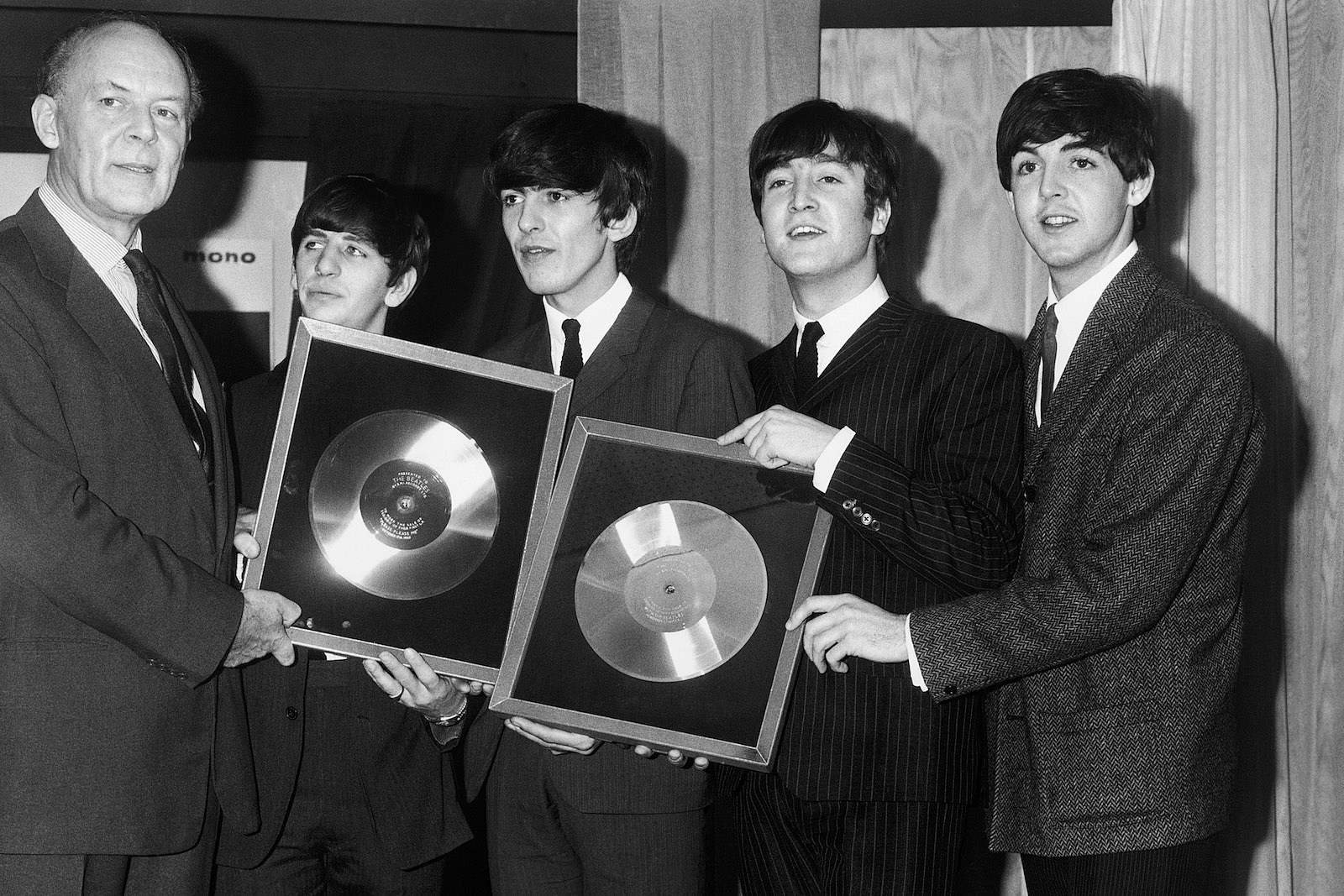
Dave Swanson | Published: December 17, 2023
On Dec. 17, 1963, the U.S. still had no idea what was in store. The Beatles had yet to appear on The Ed Sullivan Show, where they seemingly overnight changed the landscape of pop music forever. That wouldn't occur until February 1964.
Then Carroll James of WWDC in Washington, D.C., played a Beatles record on a mid-December day in 1963. He wasn't the first to do so in the U.S., but it was when things really caught fire.
A D.C. teenager had mailed in a request to WWDC to hear the Beatles, according to Beatles Interviews. "I wrote that I thought they would be really popular here, and if [James] could get one of their records, that would really be great," said Marsha Albert, that insightful teen who made the request.
Carroll James somehow secured the Beatles' new single, "I Want to Hold Your Hand," which had yet to be issued in the United States. The phones lit up and made the song an instant listener favorite. Capitol Records released "I Want to Hold Your Hand" in the U.S. the following week, and it eventually reached the No. 1 spot in Billboard on Feb. 1, 1964 – a place it would occupy for 11 straight weeks.
The Beatles made their first appearance on U.S. television a month earlier on Nov. 18 as part of the Huntley-Brinkley Report, which featured a four-minute segment by reporter Edwin Newman. Three weeks before that, on Oct. 29, the Washington Post ran a story with the headline, "Thousands of Britons 'Riot': Liverpool Sound Stirs Up Frenzy." Both Time and Newsweek published their own Beatles stories in mid-November. The rest is history.
{snip}

Dave Lifton | Published: December 18, 2013
Earlier this week, we celebrated what we thought was the 50th anniversary of the first time the Beatles were heard on U.S. airwaves. However, some new information has come to light, providing definitive evidence that ‘Please Please Me’ had received airplay in several major U.S. markets long before Carroll James spun ‘I Want to Hold Your Hand’ on Washington, D.C.’s WWDC on Dec. 17, 1963.
On his blog, The Hits Just Keep On Comin', Madison, Wisc. DJ and Top 40 historian J.A. Bartlett calls us - and the sources we cited - out for providing wrong information. Reprinted, with his permission, are his findings:
My own research a couple of years ago indicated that the Beatles had made the radio in the States in early 1963, although they were nothing special at the time. Today I consulted the fabulous Airheads Radio Survey Archive, which has collected (as of today) 35,487 radio station music surveys dated from 1955 to 1996, for the data. ARSA shows that the first Beatles song to get on American radio was “Please Please Me.” It further shows that five radio stations charted “Please Please Me” before December 1963. Others might have too, but here’s the ARSA tally:—WLS in Chicago charted it for the weeks of March 8 and March 15, 1963 (peaking at #35), before dropping it off. Some fairly exhaustive research at Kent Kotal’s Forgotten Hits establishes pretty clearly that WLS was the first station in America to play the Beatles, in late February 1963, nearly a year before the outbreak of Beatlemania across the country.
—KFXM in San Bernardino, California, charted it on the week of April 6 and again on charts dated April 27, May 4, and May 11. I don’t know about the weeks of April 15 and 22, but the April 27 survey shows “Please Please Me” in its first week on the chart, so I am guessing it probably didn’t appear.
—WQAM in Miami got on it for the last two weeks in April.
—KNUZ in Houston has it for the week of May 3.
—KEWB in San Francisco charted it for the same week, although their chart date was shown as May 4.
The most amazing tidbit of Kotal’s research claims that WFRX in West Frankfort, Illinois, was on “Please Please Me” in June 1963. A 1997 article in the St. Louis Post Dispatch reported that George Harrison’s mother sent a copy to his sister Louise, who lived in Benton, Illinois (where George would spend three weeks on vacation in September 1963), and she passed it along to a DJ at nearby WFRX. (In addition, New York DJ Murray the K claimed to have played the Beatles in late September 1963.)
Most of the early survey citations list the song as “Please Please Me” by “the Beattles,” which was how the band’s name was spelled on the record. The release was on the Chicago label Vee Jay, and because a Chicago station would have likely have paid special attention to releases on a local label, that’s more weight on the WLS claim to be first. Dick Biondi, who was on WLS in 1963 and is on WLS-FM today, has long claimed to have been the first DJ in America to play the Beatles, and there’s no reason to believe he wasn’t.
Regarding “I Want to Hold Your Hand,” Carroll James may have been first to play it on December 17—or he may not have been. It shows up on surveys for WGR and WKBW in Buffalo for the week of December 27, and on WABC for the week of December 31, and it’s reasonable to assume, as was the case with WLS, that the stations played the song for a week or two before it appeared on their surveys.
As Bartlett hints, although ‘Please Please Me’ was put in rotation in those cities, it didn’t gain traction for long anywhere. It wasn’t until the famed WWDC airing, coupled with the ‘Huntley-Brinkley Report’ segment the next day, that the American version of Beatlemania kicked off in earnest, which is probably why the James story had been accepted as gospel for so long.
We thank Bartlett for bringing this piece of rock history to our attention.
And, from rdsharp:
Sun Dec 17, 2023: Sorry, but that's not accurate. Dick Biondi at WLS was the first, several months before that.
While Beatlemania arrived in the United States in 1964, the first time a Beatles song was played on the radio in the U.S. was in late February 1963. Dick Biondi of WLS in Chicago was the first American DJ to play the Beatles hit “Please Please Me." It peaked the WLS charts at #35 for the weeks of March 8 and March 15, 1963 and then dropped off. The Beatles had other songs released in America in 1963, but none charted nationally on Billboard.
National Association of Broadcasters Radio 100.
WLS Surveys
The bright sound of Chicago Radio
SILVER DOLLAR SURVEY
MARCH 8, 1963
Survey courtesy Doug Scherer and Aaron Mintz
LAST THIS WEEKS
WEEK WEEK PLAYED
3 1. The End Of The World.................................Skeeter Davis-RCA 8
1 2. Walk Like A Man......................................Four Seasons-Veejay 9
2 3. The Rhythm Of The Rain...................................Cascades-Valiant 10
4 4. Ruby Baby...........................................................Dion-Columbia 10
5 5. Wild Weekend........................................................Rebels-Swan 8
20 6. South Street..........................................................Orlons-Cameo 7
11 7. Our Day Will Come..............................Ruby & Romantics-Kapp 8
6 8. You're The Reason I'm Living......................Bobby Darin-Capitol 9
15 9. Linda............................................................Jan & Dean-Liberty 5
17 10. Blame It On The Bossa Nova..................Eydie Gorme-Columbia 5
9 11. What Will Mary Say..............................Johnny Mathis-Columbia 9
8 12. Little Town Flirt..........................................Del Shannon-Big Top 11
7 13. Hey Paula.....................................................Paul & Paula-Philips 13
31 14. Our Winter Love.........................................Bill Pursell-Columbia 4
-- 15. He's So Fine........................................................Chiffons-Laurie 3
14 16. I Wanna Be Around................................Tony Bennett-Columbia 8
24 17. I Got Burned.................................................Ral Donner-Reprise 5
27 18. One Broken Heart..........................................Elvis Presley-RCA 6
29 19. Sun Arise............................................................Rolf Harris-Epic 5
18 20. Butterfly Baby............................................Bobby Rydell-Cameo 7
21 21. In Dreams..............................................Roy Orbison-Monument 5
30 22. I'm In Love Again/That's All........................Rick Nelson-Imperial 6
26 23. Love For Sale...............................................Arthur Lyman-Hi Fi 5
32 24. How Can I Forget....................................Jimmy Holiday-Everest 5
28 25. Yakety Sax.......................................Boots Randolph-Monument 6
-- 26. Tell Him I'm Not Home.............................Chuck Jackson-Wand 3
37 27. Theme From Lawrence Of Arabia...........Ferrante & Teicher-UA 5
35 28. Don't Wanna Think About Paula.....................Dickey Lee-Smash 4
-- 29. Young Lovers...............................................Paul & Paula-Philips 3
-- 30. Don't Set Me Free...................................Ray Charles-ABC Para 5
-- 31. Yellow Bandana........................................Faron Young-Mercury 5
-- 32. Blue............................................................Jack Reno-FonoGraf 4
-- 33. Young & In Love.......................................Dick & Dee Dee-WB 3
-- 34. Do The Bird............................................Dee Dee Sharp-Cameo 4
-- 35. Sax Fifth Avenue.........................................Johnny Beecher-WB 3
-- 36. Mr. Bass Man...........................................Johnny Cymbal-Kapp 3
38 37. All I Have To Do Is Dream..............Richard Chamberlain-MGM 5
-- 38. Don't Say Nothin' Bad..................................Cookies-Dimension 3
-- 39. On Broadway.....................................................Drifters-Atlantic 3
-- 40. Please Please Me..............................................Beattles-Vee Jay 3
Note the early appearence of the Beatles at number 40 spelled "Beattles".
FEATURED ALBUMS
THE KINGSTON TRIO #16--KINGSTON TRIO--CAPITOL
TEENAGE TRIANGLE--DARREN, FABARES, PETERSON--COLPIX
OUR WINTER LOVE--FELIX SLATKIN--LIBERTY
WLS 1963 index
The bright sound of Chicago Radio
SILVER DOLLAR SURVEY
MARCH 15, 1963
Survey courtesy Rick Rumick
THIS LAST WKS
WEEK WEEK PLD
1. The End Of The World.........................Skeeter Davis-RCA 1 9
2. He's So Fine.................................................Chiffons-Laurie 15 4
3. Wild Weekend.................................................Rebels-Swan 5 9
4. Rhythm Of The Rain...................................Cascades-Valiant 3 11
5. Walk Like A Man................................Four Seasons-Veejay 2 10
6. Ruby Baby.....................................................Dion-Columbia 4 11
7. South Street...................................................Orlons-Cameo 6 8
8. Our Day Will Come.......................Ruby & Romantics-Kapp 7 9
9. Linda......................................................Jan & Dean-Liberty 9 6
10. Our Winter love....................................Bill Pursell-Columbia 14 5
11. Blame It On The Bossa Nova...........Eydie Gorme-Columbia 10 6
12. Please Don't Mention My Name.....Shepherd Sisters-Atlantic -- 6
13. Sun Arise.....................................................Rolf Harris-Epic 19 6
14. In Dreams........................................Roy Orbison-Monument 21 6
15. Out Of My Mind...........................Johnny Tillotson-Cadence -- 5
16. Don't Wanna Think About Paul................Dickey Lee-Smash 28 5
17. All I Have To Do Is Dream........Richard Chamberlain-MGM 37 6
18. I Got Burned..........................................Ral Donner-Reprise 17 6
19. Don't Be Afraid Little Darlin'.........Steve Lawrence-Columbia -- 4
20. One Broken Heart For Sale......................Elvis Presley-RCA 18 7
21. How Can I Forget..............................Jimmy Holiday-Everest 24 6
22. Young And In Love.............................Dick & Dee Dee-WB 33 4
23. Blue...................................................Jack Reno-Phono Graf 32 5
24. Love For Sale.........................................Arthur Lyman-Hi Fi 23 6
25. Tell Him I'm Not Home.......................Chuck Jackson-Wand 26 4
26. Do The Bird......................................Dee Dee Sharp-Cameo 34 5
27. Young Lovers........................................Paul & Paula-Philips 29 4
28. Yellow Bandana.................................Faron Young-Mercury 31 6
29. Sax Fifth Avenue...................................Johnny Beecher-WB 35 4
30. Pipeline............................................................Chantays-Dot -- 2
31. Castaway...................................................Haley Mills-Vista -- 5
32. Mr. Bass Man.....................................Johnny Cymbal-Kapp 36 4
33. On Broadway...............................................Drifters-Atlantic 39 4
34. Don't Say Nothin' Bad............................Cookies-Dimension 38 4
35. Please Please Me.........................................Beattles-Veejay 40 4
36. Pin A Medal On Joey...........................James Darren-Colpix -- 3
37. Can't Get Used To Losing You.......Andy Williams-Columbia -- 2
38. Sandy.................................................................Dion-Laurie -- 3
39. Little Star.......................................Bobby Calendar-Roulette -- 5
40. Puff.................................................Peter, Paul & Mary-WB -- 3
FEATURED ALBUMS
THE END OF THE WORLD--SKEETER DAVIS--RCA
I WANNA BE AROUND--TONY BENNETT--COLUMBIA
GOLDEN HITS--VOL. 2--BROOK BENTON--MERCURY
WLS 1963 index
Sun Feb 11, 2024: Here is a 2024 update about the claim that WWDC's Carroll James was the first DJ in the US to play a Beatles song.
werdna
(1,020 posts)In 1964 yours truly was a mere 6 years old living in Arlington VA. Our next door neighbors had a teenage daughter with downs syndrome who adored the Beatles. Her father managed to get tickets to the concert at the Coliseum, complaining about the exorbitant cost of $4! She came back with a near life-size cardboard cutout of the four lads from Liddypool, signed by they themselves! I remember visiting them (the neighbors, that is) and seeing it, although, at that time, with my tender naive age, I was rather indifferent. Would love to get my hands on that cutout now!
